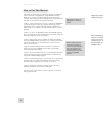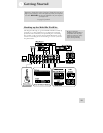
A Tour of the MultiMix FireWire
2
15
even added to the main mix via the 2TK TO MIX switch in the
master section of the mixer.
The 2-TRACK INPUT is blended with any signal coming back
from a computer over the Firewire connection.
MAIN MIX OUT
These 1/4” jacks are where the signal on the main mix bus leaves
the mixer. From there you can send it to a recorder or a PA system.
The level of this signal is controlled by the MAIN MIX fader.
CTRL RM OUT
You can use these 1/4" jacks to send the control room signal to
the input of the amplifier driving your monitors or headphones.
This output can carry several different signals, depending on which
source you have selected in the master section of the mixer.
Channel Strips
The eight channel strips are virtually identical to each other, with
the only difference being that channels 1 – 4 are mono and
channels 5 – 12 are stereo. Each channel strip contains the
following components.
Fader
The fader controls how much of the signal from the mic or line
inputs is sent to the channel. To adjust the level, simply slide the
fader up and down to the desired level. In the lowest position,
levels are cut completely, and in the uppermost position you get an
additional 10dB of gain. When the fader is at 0, it is at unity gain,
where the level of the output equals the level of the input.
MUTE / Alt 3/4
This switch has two purposes. The mute function is pretty self-
explanatory: when you press the switch, the channel’s output is no
longer routed to the main mix output. The second purpose of this
switch is that in addition to muting a channel, it also routes it to
the ALT 3/4 OUT found in the patchbay. This is where you get
the MultiMix’s extra stereo bus. If you don’t have anything
connected to the ALT 3/4 OUT, the switch acts only as a mute
button. If you do have something connected—say, a multitrack
recorder—this button acts as a signal router.
PFL / SOLO
The PFL / SOLO switch allows you to single out a channel so you
can make adjustments to it before you run it into the main mix.
This is useful for setting an instrument’s gain or EQ and for
troubleshooting. PFL stands for “pre-fade listen.” In other words


















